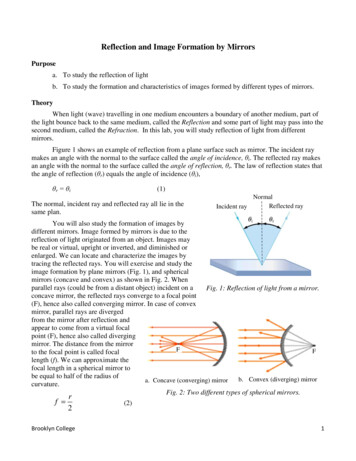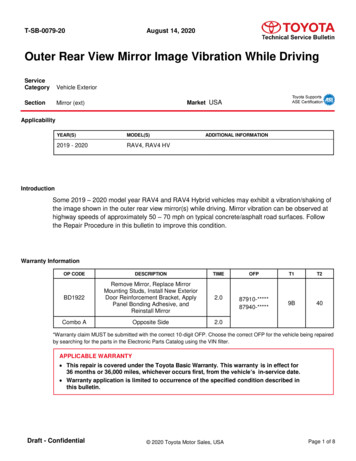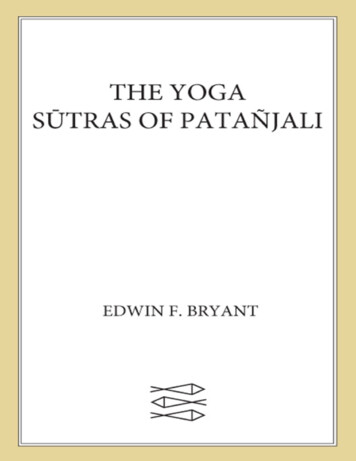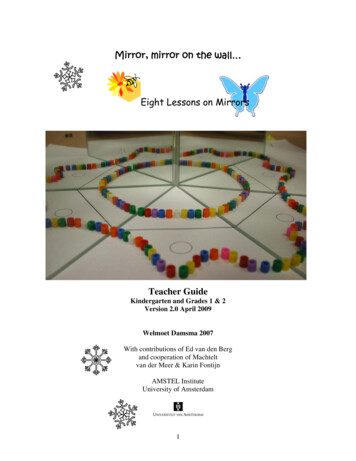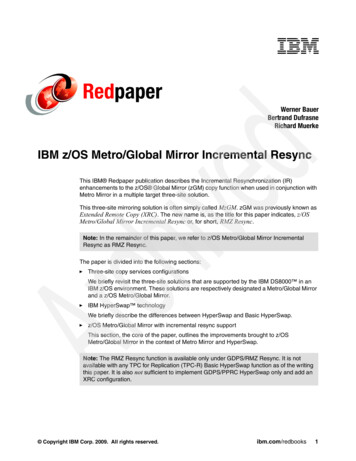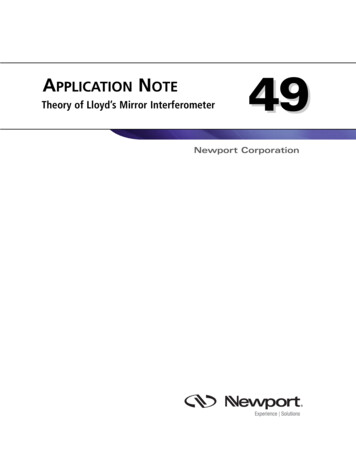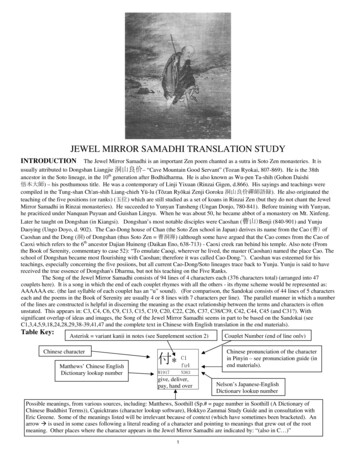
Transcription
JEWEL MIRROR SAMADHI TRANSLATION STUDYINTRODUCTIONThe Jewel Mirror Samadhi is an important Zen poem chanted as a sutra in Soto Zen monasteries. It isusually attributed to Dongshan Liangjie 洞山良价– “Cave Mountain Good Servant” (Tozan Ryokai, 807-869). He is the 38thancestor in the Soto lineage, in the 10th generation after Bodhidharma. He is also known as Wu-pen Ta-shih (Gohon Daishi悟本大師) – his posthumous title. He was a contemporary of Linji Yixuan (Rinzai Gigen, d.866). His sayings and teachings werecompiled in the Tung-shan Ch'an-shih Liang-chieh Yü-lu (Tõzan Ryõkai Zenji Goroku 洞山良价禪師語録). He also originated theteaching of the five positions (or ranks) (五位) which are still studied as a set of koans in Rinzai Zen (but they do not chant the JewelMirror Samadhi in Rinzai monasteries). He succeeded to Yunyan Tansheng (Ungan Donjo, 780-841). Before training with Yunyan,he praciticed under Nanquan Puyuan and Guishan Lingyu. When he was about 50, he became abbot of a monastery on Mt. Xinfeng.Later he taught on Dongshan (in Kiangsi). Dongshan’s most notable disciples were Caoshan (曹山)Benji (840-901) and YunjuDaoying (Ungo Doyo, d. 902). The Cao-Dong house of Chan (the Soto Zen school in Japan) derives its name from the Cao (曹) ofCaoshan and the Dong (洞) of Dongshan (thus Soto Zen 曹洞禅) (although some have argued that the Cao comes from the Cao ofCaoxi which refers to the 6th ancestor Dajian Huineng (Daikan Eno, 638-713) - Caoxi creek ran behind his temple. Also note (Fromthe Book of Serenity, commentary to case 52): “To emulate Caoqi, wherever he lived, the master (Caoshan) named the place Cao. Theschool of Dongshan became most flourishing with Caoshan; therefore it was called Cao-Dong.”). Caoshan was esteemed for histeachings, especially concerning the five posiions, but all current Cao-Dong/Soto lineages trace back to Yunju. Yunju is said to havereceived the true essence of Dongshan's Dharma, but not his teaching on the Five Ranks.The Song of the Jewel Mirror Samadhi consists of 94 lines of 4 characters each (376 characters total) (arranged into 47couplets here). It is a song in which the end of each couplet rhymes with all the others - its rhyme scheme would be represented as:AAAAAA etc. (the last syllable of each couplet has an “u” sound). (For comparison, the Sandokai consists of 44 lines of 5 characterseach and the poems in the Book of Serenity are usually 4 or 8 lines with 7 characters per line). The parallel manner in which a numberof the lines are constructed is helpful in discerning the meaning as the exact relationship between the terms and characters is oftenunstated. This appears in: C3, C4, C6, C9, C13, C15, C19, C20, C22, C26, C37, C38/C39, C42, C44, C45 (and C31?). Withsignificant overlap of ideas and images, the Song of the Jewel Mirror Samadhi seems in part to be based on the Sandokai (seeC1,3,4,5,9,18,24,28,29,38-39,41,47 and the complete text in Chinese with English translation in the end materials).Table Key:Asterisk variant kanji in notes (see Supplement section 2)Chinese characterMatthews’ Chinese EnglishDictionary lookup number付*C1fu4M1917Couplet Number (end of line only)Chinese pronunciation of the characterin Pinyin – see pronunciation guide (inend materials).N363give, deliver,pay, hand overNelson’s Japanese-EnglishDictionary lookup numberPossible meanings, from various sources, including: Matthews, Soothill (Sp.# page number in Soothill (A Dictionary ofChinese Buddhist Terms)), Cquicktrans (character lookup software), Hokkyo Zammai Study Guide and in consultation withEric Greene. Some of the meanings listed will be irrelevant because of context (which have sometimes been bracketed). Anarrow Æ is used in some cases following a literal reading of a character and pointing to meanings that grew out of the rootmeaning. Other places where the character appears in the Jewel Mirror Samadhi are indicated by: “(also in C )”1
N4912M5415N8M4411N2113M3364N2422Treasure, precious, rare,jewel, valuable (also inC12, 38)Mirror, lens, glass,glasses (also in C12)ThreeSamadhi (see below)JT: Japanese translation: 寶鏡三昧歌 (sometimes: 宝鏡三昧)Obscure, dark, darkenSong, lyrics, sing, chant(also in C42)Notes: (the abbreviations usedhereare as indicated in theJR: Romaji of Japanese translation: Hokyo Zanmaikatranslationcomparison field)CT: Cleary, Timeless Spring: Song of the Jewel Mirror Samadhi (In an unpublished form, it wasOn寶- 大雄寶殿 –enititled: “Song of the Jewel Mirror Awareness”)Great Hero Treasure Shrine is theCF: Cleary, Five Houses of Zen: Song of Focusing the Precious Mirrorname of the Buddha Hall inCL: Luk, Chan and Zen Teaching Vol II: Seal of the Precious Mirror SamadhiChinese monastaries. (Also note:FW: Fronsdal and Weitsman, unpublished translation: Song of the Bright Mirror SamadhiHJ: Graham Healey & Shindo Gensho (Richard Jones): Treasure-Mirror Samadhi宝 is an alternate form of thisJC: JC Cleary: Diamond Mirror samadhicharacter.)NF: Norman Fischer: Notes toward a possible translation draft of the Jewel Mirror Samadhi (1995?)Samadhi Æ awareness,RB: Blythe, Zen and Zen Classics, Vol II: The Treasure-Mirror of Heavenly Blissconcentration, meditation, trance,RM: Reiho Masunaga: Hokyozammai(probably the first published English translation)absorbtion, putting together,SA: Kennett, Zen is Eternal Life: The Most Excellent Mirror-Samadhicomposing the mind, intentSY: Sheng-yen, The Infinite Mirror: Song of the Precious Mirror Samadhicontemplation, perfectTH: Kaz Tanahashi and Joan Halifax: Song of the Jewel Mirror Awareness.absorption, union of the meditatorTN: Toshu Neatrour; Sheng-yen; Kaz Tanahashi online at www.sacredwith the object of meditation,texts.com/bud/zen/hz/ha.htm: The Song of the Jeweled Mirror Samadhiinterpreted by 定(decide, settle,TP: Soto Zen Text Project Translation, Soto Zen Sutra Book: Precious Mirror Samadhifix)- the mind fixed andTS: Tanahashi and Schneider: Song of the Bright Mirror Samadhiundisturbed.“It may pass fromWP: Powell: Jewel Mirror Samadhiabstraction to ecstasy, or rapture,ZC: New ZC Version (as of 2004): Song of the Jewel Mirror Samadhior trance.” Dhyana represents aTranslations for certain verses only:simpler form of contemplation.AV: Alfonso Verdu, from Dialectical Aspects in Buddhist Thought - C18-20.“When the mind has beenCC: Chang Chung-Yuan, “Samadhi as Reflection from the Precious Mirror” – C3-4, 42-43concentrated, the will isCW: Clouds in Water Liturgy: Song of the Jewel Mirror Samadhi undivded.” Sp.66. (See also theC4,C6,C9,C21,C24,C27,C28,C47.section on Samadhi in theJW: John Wu – C24, 30, 46.supplemental materials at theTO: From www.theosophy.org, by “Hermes,” 1988 – C3, C4, C42 and C43.WL: Whalen Lai: Sinitic Mandalas: The Wu-wei-t’u Of Tsao-shan: Samadhi Song of the Treasure end)The only other teaching ofor Jewelled Mirror - C18-C20.Dongshanconcerning Samadhi isZC2002: The version chanted at SFZC 2002-2003, it is only quoted where it diverges from the TP:foundinsection61 of the RecordSoto Zen Text Project Translation above – C18, C21, C39, C47ofDongshan(WPpg.45): AfterZS: Victor Sōgen Hori, Zen Sand: The Book of Phrases for Koan Practice. With the citation numberCh’in-shanhadbeendoing sitting- C3, C9, C16, C46.meditationtogetherwithYen(Sources for the translation comparison section are listed after the abbreviations on this page only)t’ouandHsueh-feng,theMasterNotes and commentary only:brought them tea. However,(Quotes and summaries from other sources also appear in the notes and commentary field.)Ch’in-shan had closed his eyes.GI: From www.gileht.com. (Gileht’s extensive website has a Madyamaka focus and he probablyoverreads Madhyamaka teachings into the Jewel Mirror Samadhi in his comments. He also sees a “Where did you go?” asked thekind of sub-theme of esoteric Buddhism. Some of his comments have been included here (C7, 10, Master. “I entered samadhi,” saidCh’in-shan. “Samadhi has no11, 12, 18, 19, 20, 21, 27, 42, 45, 46, 47).)entrance. Where did you enterMW: (Mel Weitsman) From a class on the Precious Mirror Samadhi at Berkeley Zen Center byfrom?” asked the Master. (AlsoSojun Mel Weitsman in the Fall of ‘99 (tapes & handouts available at the BZC library)(notessee the Nagarjuna quote in theincluded here do not represent word-by-word transcriptions).NH: Nan Huai-Chin. Working Toward Enlightenment, (JC Cleary trans) Samuel Weiser, Inc 1993 notes on the fire simile in C7)WP: The “jewel mirror” is ,C47)imagethat appears frequently inRA: Tenshin Reb Anderson – comments collected from various talks 1994-2003.(title, C2, C5, C6,Buddhistliterature; it can beC18, C19, C21, C34, C47)found,forexample, in the TaRS: Robert Sharf, Coming to Terms with Chinese Buddhism, A Reading of the Treasure Storechih-tulun(acommentary on theTreatise. University of Hawaii Press, 2002 (title, C3, C5, C12, C13, C18, C24, I Ching quotes)PrajnaParamitaattibuted toSR: Suzuki-rōshi, Shunryu – comments from transcribed talks. (title, C13 and five positions (sectionNagarjuna),ch.6and then))Vimalakirti Nirdesa Sutra.VH: Victor Sōgen Hori, Zen Sand: The Book of Phrases for Koan Practice. University of HawaiiZS 8.435: The six realms andPress: 2003. (combines and translates the Zen capping phrase collections Zenrin Kushufourbirths are the playground of(Shibayama) and Shinsan Zengoshu (Etsudo)) Some points from Hori’s introduction, notes andsamadhi.glossary are included here.2
Maezumi-roshi: Four generations after Shih-t'ou, Master Tung-shan Liang-chieh, the founder of Chinese Soto Zen, took up thisintimacy and wrote San-mei-k'o or Jeweled-Mirror Samadhi. The jewel is one's true entity; the mirror, the objective spheres reflectingthe parts of one's own life. The samadhi is the unity, the Buddha's wisdom that Guatama himself proclaimed at the moment of hisenlightenment: "How miraculously wondrous! All beings have the Tathagata's wisdom and virtue." The intimacy is simply realizingthat your true nature and the phenomenal world are meeting right here, now, as your life. (from the preface to Two Arrows MeetingMid-Air: The Zen Koan)MW: Samadhi is “being one with.” A jewel has many facets – Buddhism is like a gem with many sides. The mirror is like thesource. It reflects reality. It is reality. The mirror is wholeness, without partiality. The mirror has no mind. It makes no discriminations.It simply reflects, seeing things as it is.The mirror is precious and we should be one with it.Charles Muller: The Baojing sanmei, by Dongshan Liangjie 洞山良价. A popular Chan text, which explains the five ranks 五位,stating that the eternal and the transitory are interfused. [The Baojing sanmei is] A samādhi transmitted from the Buddha; refers to theoriginal state of mind which neither arises nor perishes and is not subject to any change. This mind clearly reflects all existenceswithout any mistake just as a clear mirror does.The early Chan text Shodoka (證道歌) by Yongjia (a succssor to the 6th ancestor, 665-713) is also a “song” (歌): “The Song ofEnlightenment.” It also uses mirror and jewel imagery: “Having given up wiping dust from the mirror, its brilliance is completelyseen.” “You can see your reflection in a mirror; but can you grasp the moon reflected in the water?” “This priceless jewel can be usedwithout hesitation in caring for beings and ripening potentials.” “The luminous mirror of Knowing reflects all shown it, its vastbrilliance pervades numberless worlds.” “Mind arises with experiences as its objects. Subject and object are dust on a mirror.” “Free ofdust, the mirror shines. The Actual Nature is known when mind and things do not arise.” “Understanding what this precious jewel ofmind is I now transmit it to any who will receive it.” (See also the notes to C7, C11 and C42)CT: Samadhi, concentration, meditation, trance, absorption, here we render as awareness because of convenience, to avoid any suggestionof paranormality. The great Baizhang, with whom Dongshan’s teacher Yunyan studied for twenty years, did not use the term samadhi for themirror awareness, which he called the source, the king, the elixir of immortality; as long as it is not disturbed by anything in any circumstances,passing through all color and sound without lingering, it is the guide; yet he said one should not remain in the state of the mirror all the time.Though one must some time return to the source, it is still necessary, as Loupu said, to ‘see the king in the busy marketplace.’ In Dongshan’ssong, he speaks of this awareness sometimes as a medicinal trance, or simply basic awareness empty letting the flow through.The Mirror Awareness in the Record of Baizhang Huaihai (Hyakujo Ekai, 720-814): Baizhang was a disciple of Mazu along withNanquan (Nanquan was one of the first Chan masters Dongshan practiced under, and Dongshan’s teacher, Yunyan, studied withBaizhang for 20 years). The phrase “mirror awareness”( 鑑覺) appears in The Extensive Record of Baizhang about 20 times. Ratherthan using the character: 鏡 for mirror as in the title of the Jewel Mirror Samadhi, the following character appears: 鑑, which alsomeans mirror. And rather than samadhi, 三昧, there is the character: 覺 bodhi, awareness, enlightenment, illumination, apprehend, toawake, perceive, realize – “awakening to the real in contrast to the seeming.”(Sp.480) Baizhang’s teachings relating the “mirrorawareness” have some close parallels to teachings in the Jewel Mirror Samadhi. Passages are quoted in the notes to: C5, C6, C10, C11,C13, C25, C27, C30 (from the “Sayings and Doings of Pai-chang” translation by Thomas Cleary).SY: The mirror is our true self. It is precious because no matter how long it has been hidden, forgotten, and covered with dust, itnever loses its power of illumination and reflection. The precious mirror is not an ordinary mirror, so the analogy must bestretched. An ordinary mirror has a finite shape and size. It has sides, a front and a back. The precious mirror, however, has noboundaries. It cannot be defined in terms of shape and size Samadhi refers to the power of the precious mirror, which manifestsonly when one attains the most profound level of samadhi. At this stage, all attachments fall away. The power that manifests istwo-fold: it benefits oneself by removing vexations, and it benefits others by helping them to find their own precious mirror. Thisis the power, the samadhi – of the precious mirror Several Buddhist works have been written in the form of songs or poems Ateaching written in verse is easily communicated to others. Verse helps the reader absorb the material quickly and thoroughly.”Hakuin (commenting on the 2nd of the 5 positions): “All the myriad phenomena before his eyes – the old and the young, thehonorable and the base, halls and pavilions, verandahs and corridors, plants and trees, mountains and rivers – he regards as his ownoriginal, true and pure aspect. It is just like looking into a bright mirror and seeing his own face in it. If he continues for a long time toobserve everything everywhere with this radiant insight, all appearances of themselves become the jeweled mirror of his own house,and he becomes the jeweled mirror of their houses as well. Eihei has said: ‘The experiencing of the manifold dharmas through usingoneself is delusion; the experiencing of oneself through the coming of the manifold dharmas is satori.’ This is just what I have beensaying. This is the state of ‘mind and body discarded, discarded mind and body.’ It is like two mirrors mutually reflecting one anotherwithout even the shadow of an image between. Mind and the objects of mind are one and the same; things and oneself are not two. ‘Awhite horse enters the reed flowers’; ‘snow is piled up in a silver bowl.’ This is what is known as the Jeweled-mirror Samadhi. Thisis what the Nirvana Sutra is speaking about when it says: ‘The Tathagata sees the Buddha-nature with his own eyes.’ When you haveentered this samadhi, ‘though you push the great white ox, he does not go away’; the Universal Nature Wisdom manifests itself beforeyour very eyes ”SR: Naturalness—natural mind or—means maybe more flexible mind, you know, without sticking to something rigidly. Whenwe—when we are—when we have—when our mind is perfect freedom from everything, and when our mind is open to everything likea mirror, you know, the mirror do not have any particular image on its face always. So it is naturally—naturally it will have variousimages according to the object. That is naturalness.Morton Schlutter (from The Koan, edited by Heine and Wright, pp. 182): “One text that is sometimes cited as evidence for a SilentIllumination approach in the earliest Ts’ao-tung tradition is the famous Pao-ching san-mei. This beautiful poem does seem like acelebration of the inherently enlightened nature of all sentient beings and, in holding up the Buddha’s contemplation under the tree as amodel, it can be understood to advocate indirectly a meditation in which this enlightened nature becomes apparent. The poem is3
commonly attributed to Tung-shan Liang-chieh, although in his recorded sayings it is said that Tung-shan received it, secretly, from hismaster Yun-yen T’an-sheng (780-840). However, the text of the Pao-ching san-mei is not found in any source prior to Chueh-fan Huihung’s (1071-1128) Ch’an-lin sneg-pao chuan (published in 1123), nor is it even mentioned in any earlier source. Hui-hung states that thePao-ching san-mei was kept hidden by the early worthies and that it could not be found in earlier Ch’an collections. However, Hui-hungsays, in 1108 an unnamed old monk gave a copy of the Pao-ching san-mei to a certain official and eventually the text came into the handsof Hui-hung. Hui-hung then decided to disseminate it. Given this explanation, we might surmise that the Pao-ching san-mei was aproduct of the new Ts’ao-tung school that had come into being at the end of the eleventh century and not a text that goes back to Tungshan Liang-chieh or earlier.” (For more on Hui-hung, see the Verdu excerpts in the five positions supplement.)D.T. Suzuki: "While scholars of the Avatamsaka School (Hua-yen-tsung (Kegonshû 華嚴宗)) were making use of the intuitions ofZen in their own way, the Zen masters were drawn towards the philosophy of Indentity and Interpenetration advocated by theAvatamsaka, and attempted to incorporate it into their own discourses. For instance, Shih-t'ou (Shih-t'ou Hsi-ch'ien (Sekito Kisen 700-790石頭希遷)) in his 'Ode on Identity' (Ts'an-t'ung-ch'i (Sandõkai 參同契)) depicts the mutuality of Light and Dark as restricting eachother and at the same time being fused in each other; Tung-shan in his metrical composition called 'Sacred Mirror Samadhi' discourses onthe mutuality of P'ien (One-sided (p'ien, hen 偏)), 'one-sided', and Chêng (Correct (cheng, shõ 正)), 'correct', much to the same effect asShih-t'ou in his Ode, for both Shih-t'ou and Tung-shan belong to the school of Hsing-szu known as the Ts'ao-tung branch of ZenBuddhism. This idea of Mutuality and Identity is no doubt derived from Avatamsaka philosophy, so ably formulated by Fa-tsang. As bothShih-t'ou and Tung-shan are Zen masters, their way of presenting it is not at all like that of the metaphysician." (Essays in Zen Buddhism –Third Series 19) (See also below the section on the historical context of the five positions)Jewel imagery: ZS 4.369: A great jewel in the rough needs no polishing.ZS 7.465: It spews forth so brilliant a jewel, its light chills me to the core.ZS 8.278: The original jewel is flawless but engraving a design destroys its quality.ZS 8.399: Unaware it was a jewel, he thought it just rubble.ZS 12.28: Reveal the Dharma treasury within your breast, And deliver forth your own house treasures.ZS 12.131: The bright jewel in the cave of the blue dragon.ZS 14.194: Smash to pieces the jewel under the jaw of the black dragon ZS 20.2: It is like the stone – unaware of the flawless perfection of the jewel it possesses within itself.(see also the parable in Chapter 8 of the Lotus Sutra of the jewel sewn into the robe.)Mirror imagery: ZS 4.421: In the mirror of heaven, there is no private self.ZS 5.370: He hides himself in the bright mirror.ZS 7.283: The brilliance of the great mirror wisdom is as black as lacquer.ZS 7.466: By the light of the window, illuminating one’s mind in the ancient mirror.ZS 8.296: Indra’s net, reflections of reflections, selves and others, without end.ZS 9.26: Two mirrors reflect each other; in between, there is no image.RB: The Hokyozammai, Paoching Sammei, "The Treasure-Mirror of Heavenly Bliss," is a verse composition which has beenascribed to various authors. At the present time, Tozan (Tungshan), 807-869, is considered to be the most likely, but comparingthis incoherent and pettifogging "poem" with the account given of Tozan in his goroku, a far less gifted Zen master would be moresuitable. However, the other names suggested are Yakusan and Ungan, whom also one would not like to saddle with it.The Hokyozammai consists of 376 characters, 94 lines of 4 characters each. It is commonly read daily in temples of the Sotobranch of the Zen Sect. I doubt whether most of the monks understand what they are reciting. Even an English translation canhardly make the short-lined original appear interesting. Tozan says that the world is made out of the two elements of sameness anddifference; that words are dangerous; that the relative and absolute are one thing; that no-thought, that is, freedom fromdiscrimination and dichotomy, is the salvation of the soul; that all things must obey one another. When Zen adepts turn to literaturethey often show some fundamental shortcomings. They should stick to their shouts and blows.[After his translation he adds:] This kind of thing can hardly be found in English religious literature. It reminds us of the TibetanBook of the Dead, or the religious writings of ancient Assyria, or of the gnostics; of Swedenborg, Boehme, and the propheticalworks of Blake. There is no Zen in it. [Also see his comments on Sandokai and his comments on the five positions in hisintroduction.]RA: The jewel mirror samadhi is the awareness, the state of concentration which was transmitted by Yunyan to Dongshan a veryimportant part of our lineage is the transmission of this jewel mirror samadhi it was written by the teacher Tozan Ryokai, and part of thestory about him is that his teacher, Yunyan, transmitted that samadhi to him. Then he wrote this song about this samadhi that his teachertransmitted to him. (for Dongshan’s statement to Caoshan see the notes to C2)Yifa (from a footnote on pg 275 of The Origins of Buddhist Monastic Codes in China):The origin of using a mirror for meditationcan be found in the following quotation from Silen lu shanfan buque xingshi chao which is in turn a citation (but with slightalterations) from Da zhidu lun: “[A bodhisttva will] provide the meditator with [his own] method of meditation: a Chan stick, a Chanball, a Chan tablet, a skeleton, Chan sutras, a good teacher, ‘good illumination’ [haozhao 好照, a mirror], clothes, etc.” Sifen luxingshi chao zichi ji comments on the term haozhao, noting that some claim the illuminating mirror is suspended in the meditationhalls to aid in exercising the mind, some believe the mirror is meant to reflect a clear image, while still others hold that the mirror isintended to increase the amount of radiant light in the hall. Going back still further, we find that placing a mirror in the temple ormeditation hall is mentioned in the sutra Lengyang jing. When Ananda asked for the Buddha’s advice on proper decoration for thepractice hall, the Buddha replied that the ground must be purified and leveled and a sixteen-foot-wide octagonal altar built. A lotusflower made of gold, silver, copper, and wood is placed in the center of the altar, and bowls containing water are then set inside thelotus. Eight round mirrors are arranged around the bowls and beyond these sixteen more lotus flowers are arranged. Sixteen incense4
burners are placed between the lotus flowers. Various cakes and excellent drinks such as milk, sugar water, and honey water areoffered at the altar. Banners are hung, images of Buddhas and bodhisattvas are suspended from the walls, and images of the guardiandeities are placed on both sides of the gate. Moreover, eight mirrors are suspended in the air, facing the other eight mirros at the centerof the altar, so as to reflect the light and the images.The term “Jewel Mirror Samadhi” 寶鏡三昧 seems to have been coined by Dongshan. A computer search of the Taisho revealedno matches in earlier texts. “Mirror Samadhi” 鏡三昧 does appear in a few texts, including the Mahaparinirvana Sutra where theterm appears as part of the name of the Illumination Mirror Samadhi 照鏡三昧 (zhaojing sanmei) in a list of 25samadhis (a section from this sutra is also the basis for C14-17 below).The term “Jewel Mirror” appears in a number of sutras and commentaries.The following entry is an example.To the right is an illustration of one of the 42 hands and eyes ofAvalokiteshvara described in the Daihishin Dharani Sutra (the illustrationis from “The Dharani Sutra” translation published by the City of 10,000Buddhas (full sutra title: 千手千眼觀世音菩薩大悲心陀羅尼 –The Thousand Hands and Thousand Eyes of the Bodhisattva Hearer of theSounds of the World Great Compassionate Heart Dharani (T1064)). It is#20, called “The jeweled mirror hand and eye” The sutra says “For greatwisdom, use the Jeweled Mirror hand.” (若為成就廣大智惠者。當於寶鏡手)RS: The "treasure store" (pao-tsang 寶藏) of the title exemplifies thehyper-glossia—the complex interplay of often countervailing voices—that dominate the Treasure Store Treatise. The term "pao" (treasure) wasused in antiquity to denote treasure objects held in the possession of a clanor royal household, particularly the royal house of Chou. The earliest suchtreasures were thought to have been bestowed by mythical animals andconsisted of markings on stones, dragon scales, tortoise shells, and pieces of jade. These treasures, which included bronze tripods, awide miscellany of heavenly talismans, tablets with sacred ciphers, mysterious diagrams, and other ritual objects, were the materialreceptacles for the spiritual numen (ling).According to the Tso-chuan, "the treasures are for the protection of the people" (Legge 1961:5.671), a definition that plays on theChinese homophones pao meaning "treasure" and pao meaning "to protect." The discovery of such a treasure was trumpeted as a tokenof heaven's favor; it was tangible evidence of the emperor's virtue and his possession of the mandate of heaven. Seidel notes that thetreasures “were not necessarily unique or precious. They were not used in any kind of commercial exchange, and only exceptionally asgifts, but they were kept hidden and their possession had the mystical value of symbolizing a clan's good fortune. In the case of theroyal family, they constituted the sacra or regalia of the dynasty During the Warring States period, ambitious princes became moreand more interested in such signs of divine protection, and there developed a science of prognostication and of interpretation of thesemiraculous objects.” Kaltenmark and Seidel have traced the historical origins of the Taoist "revelation texts" to the Han apocrypha(ch'an-wei), which were themselves imperial treasures, or pao. Such texts were treasures not only because they contained a message ofspiritual potency but because they were themselves objects of mystical power—sacred talismans to be cherished and venerated.The fascination with heavenly pao continued well into the T'ang period, particularly during the reigns of emperors partial toTaoism. Hsuan-tsung's reign was punctuated by the appearance of a number of such treasures, beginning in the year 713, when a 'jadetreasure" (yu-pao) was discovered after a heavy rain opened up a fissure in the palace grounds. In 741 an epiphany of Lao-tzu led tothe discovery of a jade tablet with red characters, prompting Hsiian-tsung to change the name of his reign to T'ien-pao (HeavenlyTreasure). His son, Su-tsung (r. 756—762), was similarly blessed: in 762 the district governor of Ch'u-chou discovered thirteen "statetreasures" (kuo-pao mi) comprising a jade fowl, a jade disk, jade rings, a stone axe, and various beads, gems, and seals, whereupon theemperor adopted the new reign title Pao-ying (Treasure Response) .Morohashi cites a number of derived meanings for pao, including shen (divine), and tao (Way), and notes the use of the term as aprefix in Taoist and Buddhist compounds (MH 1.1114). The term "pao" was thus a natural choice to render the Sanskrit ratna, whichgenerally means "gem" or "jewel" but can also mean (as an appositional modifier or in nominal compounds) “jeweled" or "precious."Accordingly, pao appears in numerous Buddhist compounds, including san-pao (Sk. triratna, "three jewels," i.e., buddha, dharma, andsangha) and pao-yin (precious seal, a term appearing in the Treasure Store Treatise). the specific sense of pao-tsang that dominates later Ch'an writings can be traced in part to the Treasure Store Treatise itself. Thepao-tsang of the Treasure Store Treatise, according to Sung Ch'an writings, is a metaphor for the "true self"—the buddha-naturesecreted within the human body. The phrase from the Treasure Store Treatise most often quoted in later Ch'an literature plays onprecisely this metaphor: "Within heaven and earth, inside all the cosmos, there is obtained a singular treasure concealed in the formmountain" But despite the Buddhist permutations and abstractions, the term "pao," occurring in the midst of the multivocalic poetics ofthe Treasure Store Treatise, retains conspicuous traces of its Taoist and Shamanic heritage. (pp.143-5)RS (On four character phrasing in the Treasure Store Treatise): The overall effect is reminiscent of a number of early Ch'an works,notably the verse compositions associated with the Ox Head lineage By the T'ang. the f
JEWEL MIRROR SAMADHI TRANSLATION STUDY . INTRODUCTION The Jewel Mirror Samadhi is an important Zen poem chanted as a sutra in Soto Zen monasteries. It is usually attributed to Dongshan Liangjie 洞山良价- "Cave Mountain Good Servant" (Tozan Ryokai, 807-869).He is the 38th ancestor in the Soto lineage, in the 10th generation after Bodhidharma. He is also known as Wu-pen Ta-shih (Gohon .

